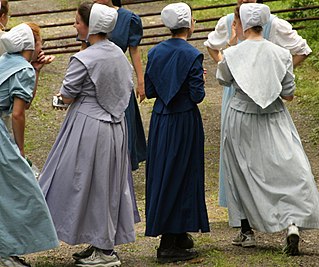Related Research Articles

Mennonites are groups of Anabaptist Christian church communities of denominations. The name is derived from the founder of the movement, Menno Simons (1496–1561) of Friesland. Through his writings about Reformed Christianity during the Radical Reformation, Simons articulated and formalized the teachings of earlier Swiss founders, with the early teachings of the Mennonites founded on the belief in both the mission and ministry of Jesus, which the original Anabaptist followers held with great conviction, despite persecution by various Roman Catholic and Mainline Protestant states. Formal Mennonite beliefs were codified in the Dordrecht Confession of Faith in 1632, which affirmed "the baptism of believers only, the washing of the feet as a symbol of servanthood, church discipline, the shunning of the excommunicated, the non-swearing of oaths, marriage within the same church", strict pacifistic physical nonresistance, anti-Catholicism and in general, more emphasis on "true Christianity" involving "being Christian and obeying Christ" however they interpret it from the Holy Bible.

Hutterites, also called Hutterian Brethren, are a communal ethnoreligious branch of Anabaptists, who, like the Amish and Mennonites, trace their roots to the Radical Reformation of the early 16th century and have formed intentional communities.

The Bruderhof is an Anabaptist Christian movement that was founded in Germany in 1920 by Eberhard Arnold. The movement has communities in the United States, the United Kingdom, Germany, Austria, Paraguay, and Australia.

The Old Order River Brethren are a River Brethren denomination of Anabaptist Christianity with roots in the Radical Pietist movement. As their name indicates, they are Old Order Anabaptists.

Old Order Mennonites form a branch of the Mennonite tradition. Old Order are those Mennonite groups of Swiss German and south German heritage who practice a lifestyle without some elements of modern technology, still drive a horse and buggy rather than cars, wear very conservative and modest dress, and have retained the old forms of worship, baptism and communion.
John A. Hostetler was an American author, educator, and scholar of Amish and Hutterite societies. Some of his works are still in print.

The Amish, formally the Old Order Amish, are a group of traditionalist Anabaptist Christian church fellowships with Swiss German and Alsatian (French) origins. They are closely related to Mennonite churches, another Anabaptist denomination. The Amish are known for simple living, plain dress, Christian pacifism, and slowness to adopt many conveniences of modern technology, with a view neither to interrupt family time, nor replace face-to-face conversations whenever possible, and a view to maintain self-sufficiency. The Amish value rural life, manual labor, humility and Gelassenheit.

Holy Matrimony is a 1994 American comedy film directed by Leonard Nimoy and starring Patricia Arquette and Joseph Gordon-Levitt. The film tells the story of a beautiful thief, hiding in a small, isolated Hutterite community, who marries a young boy in order to retrieve a hidden fortune following the death of her boyfriend, who was also the older brother of her current husband. It was the final feature film directed by Nimoy.
Vyshenky is a small village in Novhorod-Siverskyi Raion, Chernihiv Oblast, Ukraine. The population is about 500 people. The village is located on the right bank of the Desna River. It belongs to Korop urban hromada, one of the hromadas of Ukraine.
Kyrpychne is a village in Melitopol Raion, Zaporizhia Oblast, Ukraine, 20 km from Melitopol. Until 1945 it was known as Hutterthal also spelled Huttertal.
Dolynske is a village in Melitopol Raion, Zaporizhia Oblast, Ukraine, some 20 km west of Melitopol. It was originally a Hutterite village and until 1945 was known as Johannesruh or Johannesruhe.
Kushchove is a small village in Orikhiv Raion, Zaporizhia Oblast, Ukraine, some 35 km east of Zaporizhia. It has population of 191 people.
The Prairieleut, also written Prärieleut and sometimes also called Prairie People, were a branch of the Hutterite tradition from the immigration of the Hutterites to the United States in the 1870s until the about the middle of the 20th century, when they had almost totally assimilated into Mennonite congregations, especially into the Krimmer Mennonite Brethren or into mainstream society. The Prairieleut did not live in colonies, with community of goods, but on individual farms, mostly homesteads on South Dakota grasslands. During the 20th century the Prairieleut mostly lost their distinctive language Hutterisch.

The Schmiedeleut, also Schmiedeleit, are a branch of the Hutterites that emerged in 1859. It is divided into two subgroups.
The Dariusleut, also Dariusleit, are a branch of the Hutterites that emerged in 1860.
The Lehrerleut, also Lehrerleit, are a branch of the Hutterites that emerged in 1877. They are the most traditional branch of the Hutterites.
A Seeker is a person likely to join an Old Order Anabaptist community, like the Amish, the Old Order Mennonites, the Hutterites, the Old Order Schwarzenau Brethren or the Old Order River Brethren. Among the 500,000 members of such communities in the United States there are only an estimated 1,200 to 1,300 outsiders who have joined them.
Fort Pitt Farms Christian Community is a Christian Community of Dariusleut Hutterite origin and of many Hutterite traditions, but that is fully autonomous since 1999. It is located in Frenchman Butte, Saskatchewan, Canada close to Fort Pitt Provincial Park. Its spiritual leaders are Reuben Walter and Ben Walter.

Old Order Anabaptism encompasses those groups which have preserved the old ways of Anabaptist Christian religion and lifestyle.
References
- ↑ John A. Hostetler: Hutterite Society, Baltimore, MD, 1974, page 279.
- ↑ Rod Janzen and Max Stanton: The Hutterites in North America, Baltimore, MD, 2010, page 253.
- ↑ Julius Kubassekat anabaptistwiki.org